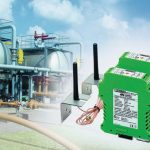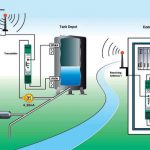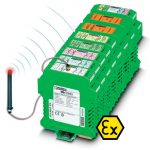Service lives of 25 or 30 years are not uncommon in process engineering systems. As a consequence, system expansions and maintenance are the order of the day. A considerable outlay often needs to be made in order to capture distant sensors. Long cable routes, various obstacles as well as difficult terrains lead to high installation costs. Inflexible wires and insufficient mobility are further reasons why users are so attracted by wireless technology.
Frank Hakemeyer
For applications in motion, such as rotating installations or moving objects, a radio path easily solves the problem of signal transmission. Slip rings and drag chains, on the other hand, are complex, expensive and require intensive maintenance. In addition, measurement values that are needed temporarily and not permanently can be captured more economically and quickly using a radio path. Although wireless technology has the potential to make process engineering systems more economical, many users still remain sceptical. Reservations concerning its functionality and reliability, not least due to the invisible way radio waves work, are deep-rooted. Initially, system components are tested experimentally or in isolated applications for various end users. This is where cable replacement systems, such as the RAD Line I/O family from Phoenix Contact, prove to be straightforward and effective problem solvers. Many system operators are currently gaining their first experience of industrial wireless and familiarising themselves with the unique features of this new technology. In the same way as when fibre-optic technology was introduced, wireless users must first learn how to handle wireless properly. An example from fibre optics is the special body of regulations governing the laying of fibre-optic cables, which includes specifications on adhering to minimum bending radii and polishing fibre ends. One particular feature that users of wireless technology are forced to get to grips with is its range. The effective range of a wireless system depends on numerous application parameters. As a result, end users with inadequate experience are often not up to the task. Under ideal conditions, a wireless technology system can function reliably up to a range of 10 km. The same system, however, can also reach its limit after only 100 m. This extreme spectrum, which is unusual for a technical parameter, is based on physical properties. Environmental conditions such as line of sight, size of the Fresnel zone, attenuation caused by reflections as well as dispersion and deflection are all factors that can influence the achievable range. It is not always possible to state accurately whether a particular radio path is viable or not. Only after a field test has supplied the required measurement parameters can the quality of the radio path be rated with any certainty. This level of uncertainty, which is a problem for many users, is an integral part of wireless technology. However, once users have acquired their initial experience with wireless technology, they see beyond its constraints and appreciate the many advantages it has to offer.
Is the future wireless?
The acceptance of wireless technology among US users is markedly higher than it is among users in Europe. Sales figures support this claim, as do the activities of various task forces and user groups. Particularly where a point-to-point connection evolves from a cable replacement solution to a wireless network, the expectations placed on network behaviour become more complex and the call for open standards grows increasingly loud. Good examples of this include ISA SP100 and the Wireless Hart Group. Both interest groups are working, amongst other things, to standardise wireless sensor networks. The SP100 committee is highly focused on general process engineering, while the Wireless Hart Group concentrates on the worldwide Hart standard. As the work of these interest groups progressed, it soon became apparent that sensor networks using wireless technology only make sense when absolutely no cables are needed to connect the sensors. In addition to this purely wireless transmission, power must in this case also be supplied independently of the power grid. Extensive research is already being conducted in the area of so-called “energy harvesting“. This involves harvesting energy from the process environment via solar, kinetic, vibration and thermal energies, for example. The first energy generators based on these energy types are meanwhile being tested or are now commercially available.
Suitable for long ranges
The technology of licensed radio and mobile communications systems in the GSM band has to compete today with license-free and toll-free solutions. These include the so-called ISM bands (industrial, scientific, medical) with 433, 868 and 2400 MHz frequencies. Bluetooth and WLAN are standard technologies that originated in the office world. Despite the industry-specific improvements that have been made, these technologies do not come close to meeting the requirements of process engineering. Trusted Wireless, developed by Phoenix Contact and Omnex Control Systems, is a special, industrial wireless technology that is optimised for process applications. This technology, which operates in the 900 MHz and 2.4 GHz license-free frequency bands, offers a high degree of reliability and ruggedness. Other key features include long ranges, good interference and coexistence properties and good diagnostic options. Trusted Wireless technology is based on an FHSS (frequency hopping spread spectrum) technique. With this method, wireless transmissions are made on various narrow-band wireless channels. The transmitter and receiver change their transmission frequency continuously. The frequencies used, and the order in which they are used, form the hop pattern. This pattern is pseudo random and is only known to the transmitter and receiver. This ensures that communication between two devices cannot be tracked by third parties and that the message cannot be intercepted. Due to the constantly changing radio frequency, interference can be tolerated very easily. A narrow-band interference signal can only interfere on one frequency or a few adjacent frequencies, which may prevent the transmission of a single communication cycle. However, on the next communication cycle the wireless technology changes to another wireless frequency and thus avoids the interference signal. The Trusted Wireless technology can make use of up to 830 separate frequencies, depending on the application, which are jumped to pseudo-randomly across the entire band.
Coexistence of several systems
The coexistence of several Trusted Wireless systems is absolutely smooth, since none of the systems use all the available frequencies and each uses only a subset. In addition, the sequence of the frequencies used is so varied that the hop pattern of a Trusted Wireless system is unique. No two Trusted Wireless systems employ the same hop pattern. This means that a large number of systems can be operated in parallel, and in close proximity, without any significant interference. Trusted Wireless technology is moreover friendly to other wireless systems because it only uses very narrow-band transmission frequencies, so that other frequency hoppers (e. g. Bluetooth) can operate in parallel without problems. In addition, transmission frequencies or frequency ranges can be excluded from use, which ensures that Trusted Wireless technology can also be operated efficiently alongside WLAN systems. The reliability of Trusted Wireless technology is further increased by specific software mechanisms in the protocol. Communication packets are provided with source and destination addresses, which prevent the use of incorrectly received packets. The Trusted Wireless technology is optimised for medium and long ranges. If suitable antennas are used, and providing the legal guidelines and the maximum values are complied with, the following distances can be achieved: 25 km in the 900 MHz band at 1 W transmission capacity or 3 km in the 2.4 GHz band at 10/100 mW. These values may be exceeded or fallen short of, depending on the application.
Reliable signal transmission
Phoenix Contact banks on Trusted Wireless for its RAD-ISM-2400 wireless systems. The system reliably transmits analogue and digital signals over a distance ranging from a few hundred metres to several kilometres – even in Ex Zones 1 and 2. The unidirectional RAD-ISM-2400-SET-UD-ANT system transmits an analogue current signal to the receiver in addition to two digital signals. The system does not have to be programmed or configured, and it provides various methods for diagnosing the radio path. It is suitable for logging data or controlling distant sensors and actuators. Point-to-point connections and multiple receiver systems can likewise be set up. The bidirectional RAD-ISM-2400-SET-BD-BUS-ANT system transmits in both directions. The number of signals that can be transmitted can be increased by simply adding extension modules to the integrated bus interface. Repeaters can also be used to surmount transmission obstacles or increase the range. The system allows point-to-point connections to be set up with or without repeaters as well as multiple receiver systems. The serial RAD-ISM-2400-DATA-BD system facilitates transmission from RS232 and RS422/485 interfaces using the Trusted Wireless technology, so that wireless networks with up to 255 devices are possible.
cpp 406
Products
Wireless HART
ISA SP100
Industrial Wireless Book
Share:









